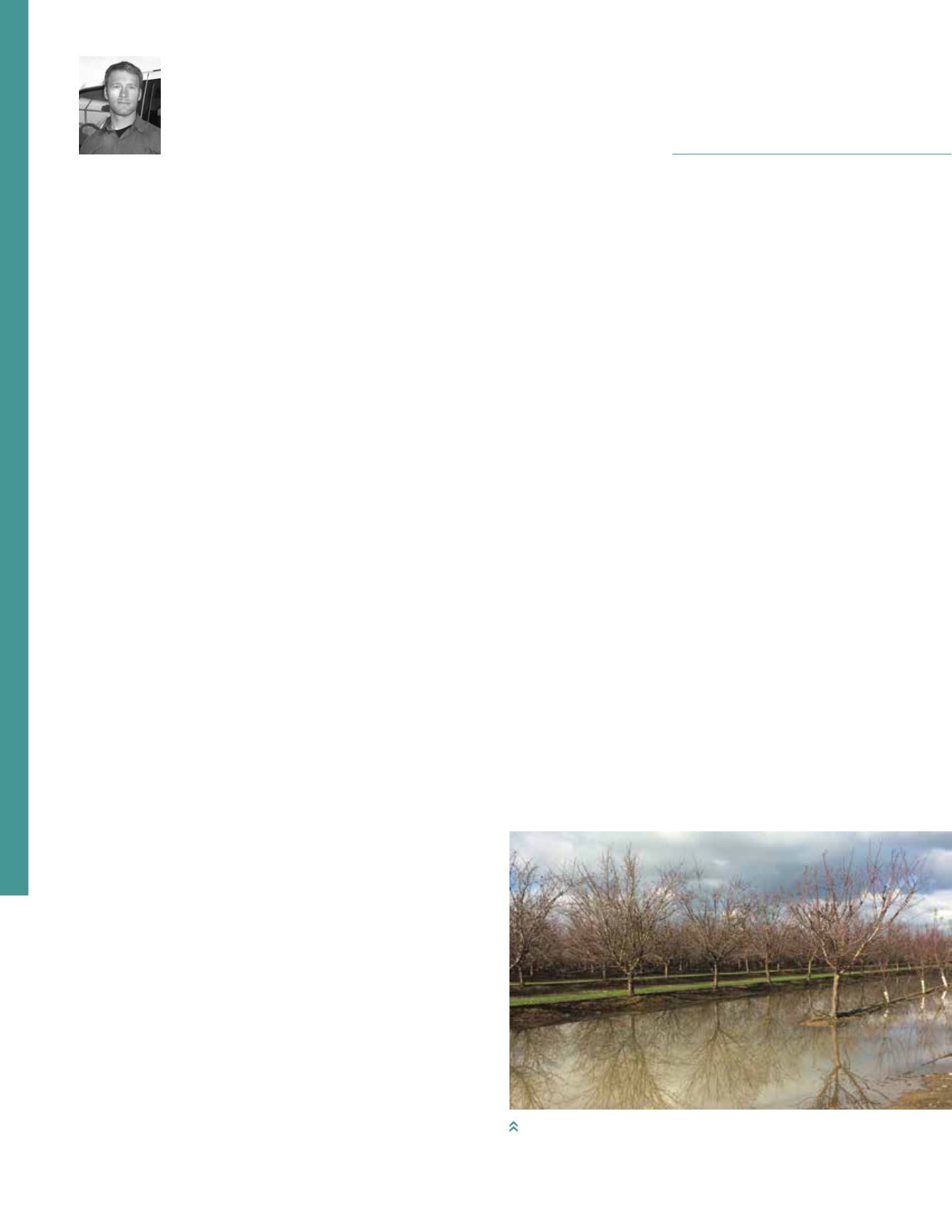
TIME TO CONSIDER
36
Almond Facts
JANUARY | FEBRUARY 2016
Time To Consider
DAVID DOLL, Tree Nut Farm Advisor, UCCE Merced County
2015 was a challenging year for many farmers and was a year for the record books. As we look forward
to 2016, be aware of a different set of challenges that occur in wet years. These include the possible
increase requirement for fungicides, field access issues due to rain, delayed planting of new blocks and
other considerations that may have been forgotten over the past four drier-than-normal years.
Fungicide sprays
Due to almond flower sensitivity to disease and bloom
conditions that are conducive for disease, most people will
spray a fungicide during this period. In wet conditions,
multiple sprays may be needed, while in dry years, zero
to one spray may suffice. Conditions that favor disease
formation include rain or heavy dew, and warmer
temperatures for Brown Rot, Anthracnose, Bacterial
Spot and Shot-hole, and cool, wet weather for Jacket-
rot. Fungicide selection should provide coverage for the
diseases of concern (Please see the fungicide efficacy table).
Since most fungicides work to protect the plant from being
infected by killing the germinating spore, bloom sprays
should be applied before rain events to provide protection
for flowers, flower parts, and emerging leaf tissue. Some
chemistries, such as FRAC groups 3 and 11, have the
ability to “reach back” because they are able to move
through the epidermis of the plant’s leaves or flowers. This
provides a slight curative component to these powerful
fungicides and makes them a great option if a spray was
missed or there wasn’t enough time to cover the acreage.
Coverage from a fungicide spray will last around two
weeks, unless significant rainfall occurs. If applying prior
to a rain event, applications will need a few hours to dry
to prevent “run-off.” In rainy weather, follow-up sprays
will be needed every 7-10 days. Some varieties – such as
‘Butte’ and ‘Carmel’- are more susceptible to disease and
may require a spray even in dry weather, while others,
such as ‘Nonpareil,’ are quite tolerant and may not need a
bloom spray. Orchard history, weather and your comfort
level should be the guidance in determining your bloom
and springtime disease control strategy.
It is important to avoid back-to-back application of
fungicides within the same mode of action. Mode of action is
simplified using the FRAC number – and thus back-to-back
applications of the same FRAC number should be avoided.
This includes pre-mixed fungicides. An example of a rotation
program for multiple sprays for rainy weather include:
1st Spray:
FRAC 9 (Scala, Vanguard)
2nd Spray:
FRAC 11 or FRAC 7/11(Gem, Abound,
Pristine, Luna Sensation, Merivon, etc)
3rd Spray:
FRAC M4 (Chlorothalonil)
4th spray:
FRAC 3, FRAC 11, or FRAC3/11 (Bumper,
Tilt, Gem, Abound, Indar, Quadris Top, Quilt Xcel, etc)
Note how the two applications of FRAC 11 were split
by rotating away to another chemistry. Keep in mind
that FRAC 3 (DMIs) do not provide any protection for
Botrytis.
Please note that the fungicides listed are
an example, not an endorsement for use. Please
refer to Timing and Efficacy Tables for full list
of tested fungicides. There are many effective
fungicides not listed in this example.
Included are the updated efficacy ratings and timings of
various fungicides for bloom time diseases. Remember to
rotate chemistries to avoid back-to-back applications of the
same mode of action or FRAC group. Rotation programs
can be challenging in wet years. Plan ahead and develop
a plan before bloom begins. There is a lot of information
regarding bloom spray timings and diseases at www.
thealmonddoctor.com and
.
Heavy rains can flood fields, preventing access. Driving within
these fields can create compaction issues that will take several
years to correct. Plan ahead!


